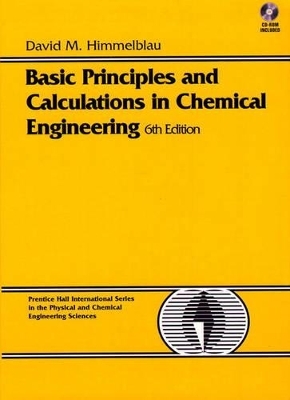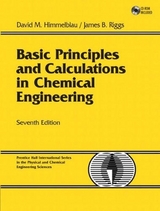
Basic Principles and Calculations in Chemical Engineering (BK/CD)
Prentice Hall
9780133057980 (ISBN)
- Titel erscheint in neuer Auflage
- Artikel merken
For first and required introductory course taken by all undergraduate chemical engineering majors.
This student-friendly introduction to the principles and calculations used in the field of chemical, petroleum, and environmental engineering is designed to help students 1) develop systematic problem-solving skills, 2) learn what material balances are, how to formulate, apply, and solve them, 3) learn what energy balances are and how to apply them, and 4) learn how to deal with the complexity of big problems. Self-contained in approach, it provides all necessary background information on units and measurement, physical properties, basic laws about the behavior of gases, liquids, and solids, and some basic mathematical tools.
(NOTE: Each chapter concludes with Supplementary References and Problems.)
1. Introduction to Chemical Engineering Calculations.
Units and Dimensions. The Mole Unit. Conventions in Methods of Analysis and Measurement. Basis. Temperature. Pressure. The Chemical Equation and Stoichiometry.
2. Problem Solving.
Techniques of Problem Solving. Computer-Based Tools. Sources of Data.
3. Material Balances.
The Material Balance. Program of Analysis of Material Balance Problems. Solving Material Balance Problems That Do Not Involve Chemical Reactions. Solving Material Balance Problems That Involve Chemical Reactions. Solving Material Balance Problems Involving Multiple Subsystems. Recycle, Bypass, and Purge Calculations.
4. Gases, Vapors, Liquids, and Solids.
Ideal Gas Law Calculations. Real Gas Relationships. Vapor Pressure and Liquids. Saturation. Vapor-Liquid Equilibria for Multicomponent Systems. Partial Saturation and Humidity. Material Balances Involving Condensation and Vaporization.
5. Energy Balances.
Concepts and Units. Calculation of Enthalpy Changes. Applications of the General Energy Balance without Reactions Occurring. Energy Balances That Account for Chemical Reaction. Reversible Processes and the Mechanical Energy Balance. Heats of Solution and Mixing. Humidity Charts and Their Use.
6. Solving Simultaneous Material and Energy Balances.
Analyzing the Degrees of Freedom in a Steady-State Process. Solving Material and Energy Balances Using Flowsheeting Codes. UNSTEADY- STATE MATERIAL AND ENERGY BALANCES. Unsteady-State Material and Energy Balances.
Appendices.
A. Answers tp Self-Assessment Tests. B. Atomic Weights and Numbers. Steam Tables. D. Physical Properties of Various Organic and Inorganic Substances. E. Heat Capacity Equations. F. Heats of Formation and Combustion. G. Vapor Pressures. H. Heats of Solution and Dilution. I. Enthalpy-Concentration Data. J. Thermodynamic Charts. K. Physical Properties of Petroleum Fractions. L. Solutions of Sets of Equations. L.1 Independent Linear Equations. L.2 Nonlinear Independent Equations. M. Fitting Functions to Data. N. Answers to Selected Problems.
Index.
| Erscheint lt. Verlag | 20.5.1996 |
|---|---|
| Verlagsort | Upper Saddle River |
| Sprache | englisch |
| Maße | 185 x 240 mm |
| Gewicht | 1322 g |
| Themenwelt | Naturwissenschaften ► Chemie ► Technische Chemie |
| Technik ► Umwelttechnik / Biotechnologie | |
| ISBN-13 | 9780133057980 / 9780133057980 |
| Zustand | Neuware |
| Informationen gemäß Produktsicherheitsverordnung (GPSR) | |
| Haben Sie eine Frage zum Produkt? |
aus dem Bereich



